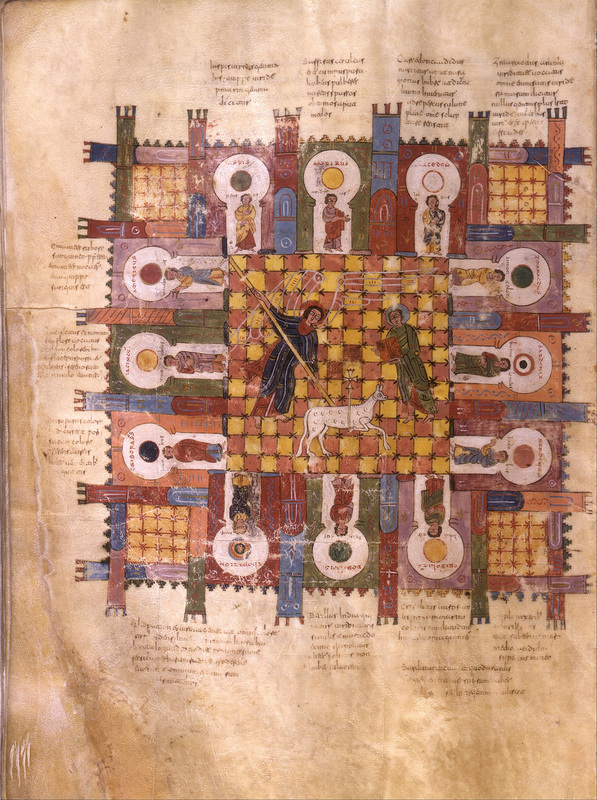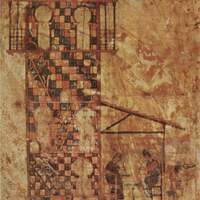Beatus manuscripts
Date:
Mid-tenth century
Location or Findspot (Modern-Day Country):
Spain
Medium:
Parchment
Dimensions:
36 x 25.5 cm
Description:
Beatus manuscripts are copies of a Commentary on the Apocalypse originally written around 775 by the Iberian monk Beatus of Liébana. One of the oldest surviving examples is the Morgan Beatus, made around 940–45. It has approximately fifty full- and half-page miniatures and another two dozen smaller images incorporated into the text of the Commentary. In addition, this manuscript includes illustrated prefatory evangelist pages and ten folios of genealogical tables; a Table and a Tree of Consanguinity to illustrate Isidore of Seville's De adfinitatibus et gradibus (a discussion of the structure and degrees of kinship); and an illustrated version of St. Jerome’s Commentary on Daniel. Illustrated copies of the Beatus Commentary are particularly well known for their distinctive Heavenly Jerusalem images, and the earliest witness to the tradition is the image in the Morgan Beatus.
The now-fragmentary Tábara Beatus is a copy completed in 970 at the monastery of San Salvador de Tábara. Four individuals are singled out by name for their roles in writing and illuminating this book: Monnius, Magius, Emeterius, and Senior. "The priest Monnius wrote [this]" appears at the end of the text. On the following folio, a long colophon under a large, decorative omega (the last letter of the Greek alphabet) describes the work of Magius, the distinguished master-painter, priest, and monk who died before he could finish the book, and Emeterius, Magius's student, who took over after Magius's death. On the verso is the famous image of a scriptorium, which matches the description in the colophon: "Oh high and stoney tower of Tábara, the first room where Emeterius sat bent over for three months and with all his limbs brandished the pen" (O turre tabarense alta et lapidea insup[er] prima teca ubi emeterius IIIbusque mensis incuruior sedit et cum omni membra calamum conquassatus fuit). Two monks in the image of the tower-scriptorium sit across from each other at a table with pens in their hands. They can be identified by the texts above their heads as Senior and Emeterius.
The now-fragmentary Tábara Beatus is a copy completed in 970 at the monastery of San Salvador de Tábara. Four individuals are singled out by name for their roles in writing and illuminating this book: Monnius, Magius, Emeterius, and Senior. "The priest Monnius wrote [this]" appears at the end of the text. On the following folio, a long colophon under a large, decorative omega (the last letter of the Greek alphabet) describes the work of Magius, the distinguished master-painter, priest, and monk who died before he could finish the book, and Emeterius, Magius's student, who took over after Magius's death. On the verso is the famous image of a scriptorium, which matches the description in the colophon: "Oh high and stoney tower of Tábara, the first room where Emeterius sat bent over for three months and with all his limbs brandished the pen" (O turre tabarense alta et lapidea insup[er] prima teca ubi emeterius IIIbusque mensis incuruior sedit et cum omni membra calamum conquassatus fuit). Two monks in the image of the tower-scriptorium sit across from each other at a table with pens in their hands. They can be identified by the texts above their heads as Senior and Emeterius.
Relevant Textbook Chapter(s):
6
Repository and Online Resources:
• Look through the Tábara Beatus on the website of the Archivo Histórico Nacional.
• The master-painter Magius may have been the same Magius/Maius responsible for an earlier Beatus manuscript (completed around ca. 940–45) that is
now in the Pierpont Mogan Library (MS M. 644).



